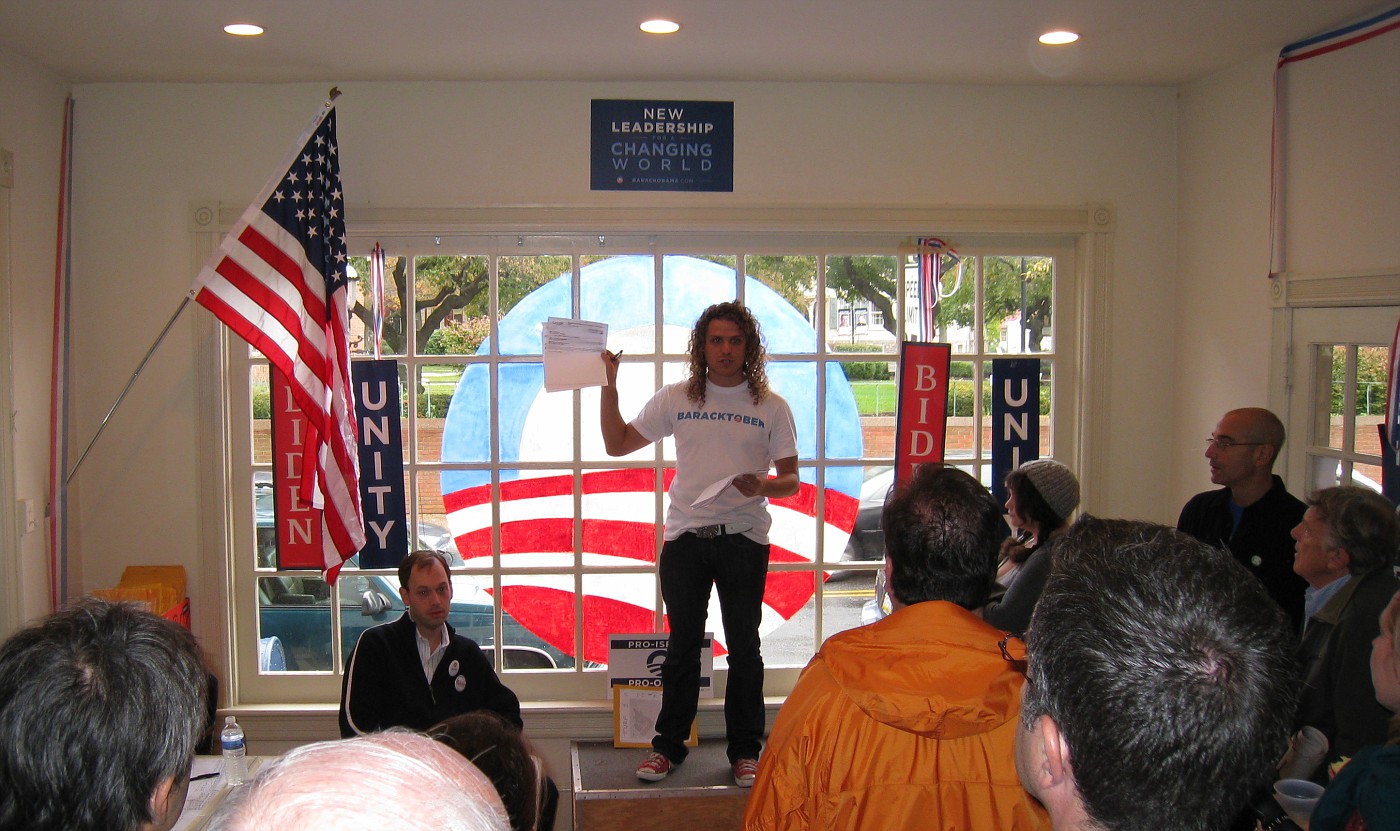
I spent the weekend volunteering for the Obama campaign, in Doylestown, Pennsylvania. This town is in the heart of Bucks County, one of the “must-win” counties in the coming election, according to politico.com. Main Street here is as close as you can get to the typical small-town “Main Street” that the candidates love to refer to in their speeches.
Volunteering for the campaign was a major watershed for me: I’ve never been so motivated by an election, and really think there is more at stake than in any previous election that I’ve voted in – and a lot of the people I spoke to over the weekend felt the same way. The experience was rewarding, and I felt that I had contributed significantly to a coming electoral success!

Briefing the volunteers
Bucks County is a real cross-section of Pennsylvania, split between Republican and Democratic voters, with diverse demographics. It has one of the highest numbers of independent or undecided voters within Pennsylvania, a state with a very large number of electoral votes.
Unlike the McCain campaign, the Obama campaign is placing a very high emphasis on face-to-face contact with potential voters. The goal is not only to sway undecided voters, but to create a sense of momentum and presence, that the campaign cares about Bucks County and is fully mobilized.

Phone bank volunteers. No robots here!
An extremely important part of the canvassing effort is to identify any problems that are preventing voters from voting, and seek to overcome them. For example, I personally met with some elderly or ill voters who felt they could not make it to the polls – for them, we were carrying absentee ballot request forms, which we filled in with them, and personally delivered to the courthouse. For others, we arranged rides to the polls on election day.
I encountered overwhelming support for Obama and the Democratic party, most strikingly from a number of elderly voters who were voting for a Democratic president for the first time in their lives. It was inspiring to meet these seniors, in their 80s and 90s, still taking a very active interest in politics and the direction of the country.
The enthusiasm of the volunteers in the Obama office was remarkable, not just the young and highly motivated campaign staff, but the volunteers from all walks of life who had come from all over the state, and from out of state, to campaign in Doylestown. One middle-aged couple from Doylestown, manning the phones, was very impressive to me: the way they engaged individual voters in caring and thoughtful conversation was a real example of how a campaign could (and should) be run.
Campaigning for Barack Obama on Main Street
I spent the weekend volunteering for the Obama campaign, in Doylestown, Pennsylvania. This town is in the heart of Bucks County, one of the “must-win” counties in the coming election, according to politico.com. Main Street here is as close as you can get to the typical small-town “Main Street” that the candidates love to refer to in their speeches.
Volunteering for the campaign was a major watershed for me: I’ve never been so motivated by an election, and really think there is more at stake than in any previous election that I’ve voted in – and a lot of the people I spoke to over the weekend felt the same way. The experience was rewarding, and I felt that I had contributed significantly to a coming electoral success!
Briefing the volunteers
Bucks County is a real cross-section of Pennsylvania, split between Republican and Democratic voters, with diverse demographics. It has one of the highest numbers of independent or undecided voters within Pennsylvania, a state with a very large number of electoral votes.
Unlike the McCain campaign, the Obama campaign is placing a very high emphasis on face-to-face contact with potential voters. The goal is not only to sway undecided voters, but to create a sense of momentum and presence, that the campaign cares about Bucks County and is fully mobilized.
Phone bank volunteers. No robots here!
An extremely important part of the canvassing effort is to identify any problems that are preventing voters from voting, and seek to overcome them. For example, I personally met with some elderly or ill voters who felt they could not make it to the polls – for them, we were carrying absentee ballot request forms, which we filled in with them, and personally delivered to the courthouse. For others, we arranged rides to the polls on election day.
I encountered overwhelming support for Obama and the Democratic party, most strikingly from a number of elderly voters who were voting for a Democratic president for the first time in their lives. It was inspiring to meet these seniors, in their 80s and 90s, still taking a very active interest in politics and the direction of the country.
The enthusiasm of the volunteers in the Obama office was remarkable, not just the young and highly motivated campaign staff, but the volunteers from all walks of life who had come from all over the state, and from out of state, to campaign in Doylestown. One middle-aged couple from Doylestown, manning the phones, was very impressive to me: the way they engaged individual voters in caring and thoughtful conversation was a real example of how a campaign could (and should) be run.